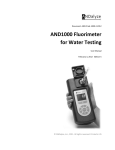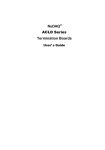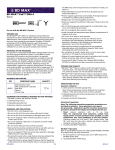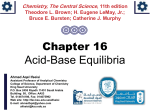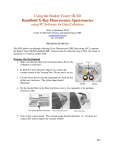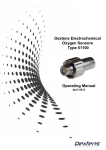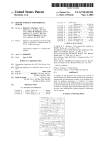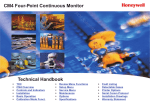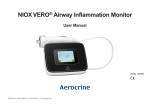Download Mercury Testing for Water Testing Detection Range
Transcript
Document: AND014‐04‐2014 Mercury Testing for Water Testing Detection Range: Positive/Negative at 2ppb (Up to 50ppb) April, 2014 Edition 3 © ANDalyze, Inc., 2012. All rights reserved. Printed in USA. Mercury Testing for Water Testing April2014 Table of Contents 2 General Information……………………………………………………………………………………………..………………... 3 2.1 Qualitative Mercury Sensor 2.2 Water Testing Guidelines 2.3 Sensor Pack: Cuvette and Sensor 2.4 Inserting Cuvette and Sensor 2.5 Sample Injection and Measurement 2.6 Pipetting Use Guidelines 3 Testing a Sample………………………………………………………………………………….………………………………….. 6 3.1 Required Materials 3.2 Testing a Sample 3.3 Results 3.4 Waste Disposal 3.5 Test for False Positive 3.6 Test for False Negative 4 Technical Specifications for ANDalyze Sensors………….……………………………………………………………. 9 4.1 Detection in Drinking Water 4.2 Interference 4.3 Product Accuracy Ranges 5 Consumables and Replacement Items…………………………………………………………………………………… 10 6 Customer Service Contact Information……………………………………………………………………..…………… 11 ANDalyze Inc. 2109 South Oak St, Suite 102, Champaign, IL 61820 USA Tel. +1 217.328.0045 www.andalyze.com Page 2 of 11 Mercury Testing for Water Testing April2014 2 General Information Important: Before continuing, please read the entire ANDalyze Fluorimeter User Manual. Pay attention to all danger, warning and caution statements. Failure to do so could result in serious injury to the operator or damage to the equipment. Make sure that the safety features of this equipment are not impaired; do not use or install this equipment in a manner other than that specified in this manual. If the equipment is used in a manner not specified by the manufacturer, the safety features of this equipment may be impaired and injury to the operator or damage to the equipment may result. 2.1 Qualitative Mercury Sensor The mercury sensor is a qualitative sensor that shows a Positive/Negative result. A “Positive” test result indicates that mercury is present at levels greater than 2 ppb. A “Negative” result indicates the water contains less than 2ppb mercury. This test does not require on‐site calibration. Important: Certain levels of interfering ions may result in a false positive or false negative. Because of this, instructions to test for these are included below. 2.2 Water Testing Guidelines Note: The below steps are for testing for dissolved, bio‐available metal ions in drinking water samples. These steps can also be used for other matrices such as surface, ground, industrial and wastewater which have been pre‐ treated. Contact ANDalyze customer service for additional application notes on pre‐treatment methods. Water Sampling For best results use freshly collected sample (unpreserved in acid) for analysis. We recommend that to every 50 mL of sample water, add approximately 4 drops of hydrogen peroxide from provided dropper bottle (except for tap water sample) and mix. This is to improve mercury testing accuracy. We recommend that you use the sample within 1 hour (maximum of 2 hours) of collection to minimize any metal loss to the walls of the sample container. Once the sample is mixed with ANDalyze sample buffer, test within 15 minutes. Temperature Range ANDalyze test kits work in the 17 – 30 ˚C (63 – 86 ˚F) temperature range. However, the most accurate and precise results are obtained in the range of 20 ‐ 25 ˚C (68 – 77 ˚F). pH Range The ANDalyze sample buffer that is provided in the sample tubes brings the pH of the test solution to pH 7.4. Generally, the raw sample water can be in the range of pH 5 – pH 8. If you have a sample which is acidic or basic, please check the pH first to confirm it is within the range prior to mixing with the ANDalyze buffer. The final buffered test solution should be ̴pH 7.4 for best results. Note: Our tests have shown that environmental samples preserved in acid to a pH < 2 cannot usually be brought to a pH of 7.4 when mixed with the ANDalyze buffer. These samples have to be first neutralized with NaOH to a pH ̴7 before mixing with ANDalyze buffer. Contact ANDalyze customer service for instructions related to pre‐treatment of highly acidic or highly basic samples. ANDalyze Inc. 2109 South Oak St, Suite 102, Champaign, IL 61820 USA Tel. +1 217.328.0045 www.andalyze.com Page 3 of 11 Mercury Testing for Water Testing April2014 2.3 Sensor Pack: Cuvette and Sensor Sensor Pack: Each sensor pack contains a cuvette, a sensor and a desiccant. These are single use and must be discarded. The desiccant should be blue in color. If it has turned completely pink in color, the sensor may not perform well. 2.4 Inserting Cuvette and Sensor Cuvette: The cuvette has an arrow which should face you when inserted. Insert the cuvette completely so that the fluorimeter lid can close. The meter and cuvette design helps to prevent improper orientation. Sensor: The square portion of the sensor can be placed on the cuvette in any orientation with the round sections facing upward. Sensors can only be used once and should be disposed of immediately after use. 2.5 Sample Injection and Measurement Fluorimeter instrument should be laid flat on a stable surface during a measurement. A buffered solution is prepared in a sample tube as described in the test section (4) which is used for measurements. A new syringe should be used to withdraw 1 mL water from a sample tube. This syringe can be attached to the top of the housing as shown in the picture. The sample should be injected through the housing into the cuvette at a constant speed of 3 – 5 seconds. The syringe and housing should be immediately removed and the sample door closed. The START button located just below the screen should be pressed immediately to start any measurement Important: After each analysis, discard all components used during the analysis including cuvette, sensor housing, sample tube, and syringes to avoid cross contamination. ANDalyze Inc. 2109 South Oak St, Suite 102, Champaign, IL 61820 USA Tel. +1 217.328.0045 www.andalyze.com Page 4 of 11 Mercury Testing for Water Testing April2014 2.6 Pipette Use Guidelines 1. New Pipette Tip – Attach a new tip by placing the end of the pipette into one of the available tips and pressing down on the pipette body. Note: Tips are disposable and should never be used more than once. Use of tips helps prevent contaminating the pipette. 2. Depress the plunger button on the top to the first stop (see photo at left). DO NOT depress all the way to the pipette body. 3. Immerse the clean tip into the solution to be withdrawn. 4. Release the pressure slowly to withdraw the solution into the tip. Important: Make sure that the pipette tip continues to be immersed in the solution during release so as to not expose the tip point to air. 5. Remove the pipette from the solution. Note: The liquid level in the tip should be approximately at the 3rd graduation. 6. Immerse the tip into the liquid present in the sample tube where the withdrawn solution is to be dispensed. 7. Slowly depress the operating button ALL THE WAY to dispense the liquid contained in the pipette tip. (See photo at right) 8. Remove the pipette and discard the used tip. Note: Dispose of tips immediately after use to prevent possible contamination of the pipette. ANDalyze Inc. 2109 South Oak St, Suite 102, Champaign, IL 61820 USA Tel. +1 217.328.0045 www.andalyze.com Page 5 of 11 Mercury Testing for Water Testing April2014 3 Testing a Sample This section will walk you through the process of testing a water sample for the desired analyte. Please read this entire section before beginning the test as parts of the test will be time sensitive. Be aware and pay attention to all notes. 3.1 Required Materials ‐ ‐ ‐ ‐ ‐ ‐ ‐ ANDalyze Fluorimeter (1) Sensor Pack with Sensor & Cuvette (1) 1 mL Syringe (1) Sample tube (with buffer) (1) Transfer Pipette (1) Clean sample collection cup (Not Provided) (1) Hydrogen peroxide dropper bottle Note: Before using the ANDalyze Fluorimeter assure that it is charged. (See Section 4.1 in the ANDalyze Fluorimeter User Manual for Battery Charging Information) 3.2 Testing a Sample 1. Start‐Up ‐ Initialize the instrument by pressing the ON/OFF button. Instrument will initialize in about 1‐2 seconds. 2. Sensor Type ‐ Ensure that the fluorimeter is on the correct metal screen. 3. Site – Confirm the site name. Do Not press “Start” until the sample is ready! 4. Pouch ‐ Open the sensor pack which contains the sensor (colored plastic housing) and plastic cuvette. Note: Unit may go into screen‐saver mode after a few minutes. Press any button to resume (Do not press and hold ON/OFF). Important: The pack contains a transparent desiccant pouch. This should be blue in color. If desiccant has turned completely pink in color, sensor may not perform well. 5. Cuvette ‐ Place the plastic cuvette in the instrument. 6. Sensor ‐ Place colored plastic sensor on the cuvette. (Any orientation). Make sure sensor is seated securely on the cuvette. ANDalyze Inc. 2109 South Oak St, Suite 102, Champaign, IL 61820 USA Tel. +1 217.328.0045 www.andalyze.com Page 6 of 11 Mercury Testing for Water Testing April2014 7. Sample Tube – Collect water to be tested in a clean cup (not provided). Add approximately 4 drops hydrogen peroxide per 50ml water (except for tap water sample), mix well. 8. Slowly pour the test water into the provided sample tube containing liquid buffer up to the 5 mL mark. If required, use one of the provided disposable plastic pipettes to transfer water accurately without exceeding 5 mL volume mark. Close cap tightly and mix well by shaking. 5 ml Important: Open tube carefully so that liquid buffer does not fall out. Do not exceed the 5 mL mark for accurate results. 9. Syringe ‐ With one of the provided syringes, draw 1 mL of buffered sample water from the sample tube into syringe. 10. Attach the syringe to the housing over the cuvette in the instrument. (Syringe tip will fit into top of sensor) Note: If the unit is left on for more than a few minutes without any activity, a screen‐saver (black screen) will be activated; press any button to resume operation (Do not press and hold ON/OFF). The instrument automatically turns off if not used for more than 5‐15 minutes (user settable). 11. Maintaining a constant speed (over 3‐5 seconds), carefully squeeze the buffered sample water through the housing into the cuvette. 12. Quickly remove sensor housing and syringe and close sample chamber door. 13. Immediately press the START button located just below the screen. 14. Remove cuvette when complete. 3.3 Results The sample will be tested, and results displayed in a negative or positive manner. A result of “POSITIVE” indicates that the level of Mercury in the sample is ABOVE 2ppb while a result of “NEGATIVE” indicates the level is BELOW 2ppb. To save the results, press the SAVE button. ANDalyze Inc. 2109 South Oak St, Suite 102, Champaign, IL 61820 USA Tel. +1 217.328.0045 www.andalyze.com Page 7 of 11 Mercury Testing for Water Testing April2014 3.4 Waste Disposal All waste produced during the test can be disposed of in normal public receptacles. Materials and liquids used are not considered harmful to people or the environment and do not require special disposal. The plastic waste is made from recyclable plastics and can be disposed of per local guidelines. 3.5 Test for False Positive If your test result for mercury is positive, the validity can be tested by testing against a false positive by adding a mercury chelator and analyzing a chelated sample In a new sample tube, add the test water up to the 5 mL mark as described before. To this add one pellet of the Mercury Chelator. Close the cap and shake well. The pellet will NOT dissolve. Analyze 1 mL of the Chelator containing sample using a new mercury sensor. If the result of this sample containing Mercury Chelator is positive, this sample matrix may have led to a false positive. Contact ANDalyze customer service. 3.6 Test for False Negative If your test result for mercury is negative, the validity can be tested by testing against a false negative. Required Material ‐ ANDalyze Fluorimeter ‐ (1) Sensor Pack with Sensor & Cuvette ‐ (1) 1mL Syringe ‐ (1) Buffer Solution Tube ‐ (1) 50 mL Self Standing Tube (To be Re‐used) ‐ Mercury Standard solution (1 ppm) ‐ (1) Hydrogen peroxide dropper bottle ‐ (1) Transfer Pipette ‐ (1) Sample Cup (Not Provided) Prepare a spiked sample by adding 50 mL of sample water to one of the provided 50 mL tubes. Add 4 drops of hydrogen peroxide from provided dropper bottle (except for tap water sample). To this add 100 µL of the provided mercury standard solution. Close the cap and shake well. Metal standard spiked for on‐site calibration is required to incubate for all environmental water samples. Add this spiked solution to a new sample tube up to the 5 mL mark. Shake well and analyze 1 mL of the sample using a new mercury sensor and cuvette. If the result of this spiked sample is negative, the sample matrix leads to false negatives due to interference, contact ANDalyze customer service or test for mercury in a lab. ANDalyze Inc. 2109 South Oak St, Suite 102, Champaign, IL 61820 USA Tel. +1 217.328.0045 www.andalyze.com Page 8 of 11 Mercury Testing for Water Testing April2014 4 Technical Specifications for ANDalyze Sensors 4.1 Detection in Drinking Water ANDalyze’s proprietary Catalytic DNA sensor uses a DNAzyme reaction that fluoresces in the presence of the target contaminant (lead, uranium, copper, mercury etc). The fluorescence of the reaction is measured using the AND 1000 fluorimeter to determine the concentration/ presence of the free analyte ion (Pb2+, UO22+, Cu2+, Hg2+ etc.) in solution. Associated US Patents Materials Used 8,815,156B2, 6,706,474, 7,192,708, ‐ ANDalyze Fluorimeter 6,890,719, 7,332,283 ‐ Mercury Sensor Kit ‐ Analyte/Metal Standard Solution Sensor Performance Mercury dilutions containing 0 ‐ 150 ppb Hg2+ were prepared in DI water. Five replicates were used for each test at each dilution. Mercury Detection Range 2 – 50 ppb mercury (Above 50 ppb mercury, there can be false negatives. If it is known that sample may contain very high levels of mercury, please dilute your sample in DI water). Note: All specifications are subject to change without notice. 4.2 Interference Interfering ion Interference Above tolerance level will cause: level 2+ False negative 80 ppm Interference tests were done with a 0 or 1 Calcium, Ca 2+ False negative Manganese, Mn 100 ppm ppb mercury in DI water plus the False negative Ammonium, NH4+ 100 ppm potential interfering ion. The interference 2+ False negative Copper, Cu 0.5 ppm tolerance levels represent the False negative Iron, Fe3+ 15 ppb concentration above which will there is a False negative Aluminum, Al3+ 20 ppb false positive for a 0 ppb mercury sample, Magnesium, Mg2+ False negative 30 ppm False negative Chloride, Cl‐ 200 ppm or false negative where mercury is 2‐ False negative Sulfate, SO 1500 ppm 4 present. Data represents an average of at ‐ False negative Dihydrogen phosphate, H2PO4 2000 ppm least three replicates. ‐ Bicarbonate, HCO3 Zinc, Zn2+ Cobalt, Co2+ Cadmium, Cd2+ Nitrate, NO3‐ Sodium, Na+ 800 ppm 200 ppm 140 ppm 60 ppm >10000 ppm >3700 ppm False negative False positive False positive False positive No interference No interference ANDalyze Inc. 2109 South Oak St, Suite 102, Champaign, IL 61820 USA Tel. +1 217.328.0045 www.andalyze.com Page 9 of 11 Mercury Testing for Water Testing 5 Consumables and Replacement Items ‐ ‐ Fluorimeter (Part Number: AND002) o Capable of measuring multiple metals. o Includes: Fluorimeter USB to MINI‐B Cable 100µL Fixed Volume Pipette and Tips pH Test Strips Sensor Kit (Part Number: AND014) o Equipment for (25) Tests Kit Includes: (25) Sensor Packs with Sensor & Cuvette (25) Sample Tubes (with buffer) (25) 1 mL Syringes (15) Disposable Transfer Pipettes 1 dropper bottle of Hydrogen Peroxide 3 mL Mercury Standard Solution (1 ppm Hg2+) Tube containing Mercury Chelator pellets (2) 50 mL tubes for testing false negatives Instruction Manual Material Safety Data Sheets (MSDS) ANDalyze Inc. 2109 South Oak St, Suite 102, Champaign, IL 61820 USA Tel. +1 217.328.0045 www.andalyze.com Page 10 of 11 April2014 Mercury Testing for Water Testing April2014 6 Customer Service Contact Information Contact us by Email: [email protected] [email protected] By Telephone: 866.364.7173 (Toll Free in US) or +1 217.328.0045 By Fax: +1 857 386 1277 Business Service Hours: 8:00am to 5:00pm Central Standard Time (USA) Monday through Friday Company Address: ANDalyze Inc. 2109 South Oak St Suite 102 Champaign, IL 61820 Website: www.andalyze.com ANDalyze Inc. 2109 S Oak Street, Suite 102 Champaign, IL 61820 USA Email: [email protected] Telephone: +1 217 328 0045 ANDalyze Inc. 2109 South Oak St, Suite 102, Champaign, IL 61820 USA Tel. +1 217.328.0045 www.andalyze.com Page 11 of 11













